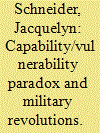| Srl | Item |
| 1 |
ID:
167677


|
|
|
|
|
| Summary/Abstract |
The Information Revolution, or the rise in computing power, allowed states to leverage digital capabilities to exert conventional military dominance. But does it also create vulnerabilities that lead to war? In this piece, I examine the relationship between military revolutions and conflict initiation and identify a capability/vulnerability paradox that suggests the degree of capability dependence created by a military revolution combined with the ability of adversaries to exploit vulnerabilities creates potential pockets of dangerous instability. These indicators suggest that greater centralisation and data dependencies could move the Information Revolution towards incentives for instability.
|
|
|
|
|
|
|
|
|
|
|
|
|
|
|
|
| 2 |
ID:
152116


|
|
|
|
|
| Summary/Abstract |
In this article, we explore how presidential risk orientations affect force employment decisions through an analysis of the use of unmanned weaponry during the Bush and Obama administrations. We hypothesize that the conception of risk plays an integral part in this choice of weaponry. In order to examine our hypothesis, we utilize the verbs-in-context system of operational code analysis to quantify the risk propensities of President Bush and President Obama during the Afghanistan War from 2001 to 2013. At the aggregate level, we find that the two presidents exhibit unique interpretations of risk with respect to manned versus unmanned weaponry. We further disaggregate our data to examine whether these preferences are fixed or fluctuate with situational changes. We find that President Bush’s risk calculations are influenced by a number of situational variables, highlighting the importance of changing decision contexts in explaining risk behaviors. President Obama’s risk calculations, on the other hand, remain constant over time lending credence to the importance of overall risk propensity in determining risk-taking behaviors. Our findings indicate that risk is an important variable in explaining the means of force employed during conflict, and that the source of this behavior can vary by leader.
|
|
|
|
|
|
|
|
|
|
|
|
|
|
|
|
| 3 |
ID:
174235


|
|
|
|
|
| Summary/Abstract |
In June of 2019, the New York Times reported that the United States was “stepping up digital incursions into Russia’s electric power grid in a warning to President Vladimir V. Putin.” 1 The reporters accused the United States of planting malware within Russian critical infrastructure under new authorities granted by the White House to the Department of Defense (DoD) for offensive cyber operations. According to the article, the acts were part of a new US strategy to use cyber operations to signal capabilities and therefore deter further Russian incursions into US critical infrastructure, 2 indicating that strategic cyber attacks—those that create immediate physical violence to large segments of civilian population or attacks that affect a state’s ability to control its nuclear forces—were now credible arrows in the US foreign policy quiver against Russia.
|
|
|
|
|
|
|
|
|
|
|
|
|
|
|
|
| 4 |
ID:
192029


|
|
|
|
|
| Summary/Abstract |
In “Will the Drone Always Get Through? Offensive Myths and Defensive Realities,” Antonio Calcara and coauthors open the article with: “Do emerging and disruptive technologies yield an offensive advantage?”Footnote1 To answer this ambitious question, they look at one highly scoped segment of unmanned or autonomous technology: Medium-Altitude Long-Endurance and High-Altitude Long-Endurance armed remotely piloted aircraft.Footnote2 The authors then use the article’s body to detail why these platforms cannot survive against modern integrated air defense systems by either avoiding detection or saturating air defenses, concluding that emerging technologies, therefore, do not necessarily lead to an offensive advantage.Footnote3 Although the article’s technical analysis is reasonably correct, in creating a straw man argument about the impetus and purpose of a rather narrow category of autonomous systems, its conclusions ultimately miss the mark. For all the technical detail, the authors miss the potential impact of autonomy on future air campaigns, a phenomenon that American pilots in training would call “unscorable at 12”—a term used when a bomb is dropped within correct parameters and yet fails to land near the impact zone.Footnote4
|
|
|
|
|
|
|
|
|
|
|
|
|
|
|
|
| 5 |
ID:
186762


|
|
|